It goes without saying that bees are vital to the balance of ecosystems across the globe. They help pollinate 80 percent of flowering plants and 75 percent of the fruits, vegetables, and nuts grown in the United States.
But while most people think of the common honeybee when they think of bees or pollinators, honeybees are only a tiny segment of many thousand species of bees found in the world.
About 20,000 different species, in fact. Of these, only 8 species of bees produce honey, and none of them are native to the US—though we do have 4,000 other bee species that are native.
Most bees are not aggressive and are not interested in people at all. They’re interested in the plants in your lawn and garden, and prefer to keep to themselves, visiting flowers and feeding on nectar.
That’s why if you do come across an aggressive bee and get stung, it’s more likely that you accidentally smushed it or mistook it for a wasp (like a yellowjacket). But how can you tell what’s what?
Bookmark this helpful visual guide, which can help you identify the most common types of bees found in your backyard. You’ll get a clear breakdown below with simple tips for IDing them, including pictures, descriptions, and behavioral characteristics that differentiate each species.
How to tell the difference between bees and wasps
Before we get into bees, it’s important to understand the differences between bees and wasps.
These yellow and black insects are easily confused for each other and while they’re closely related (both belonging to the insect order Hymenoptera), a few key traits set them apart.
One easy thing to remember is that bees can only sting once before dying, while wasps can (and do!) sting multiple times.
Read more: How to Safely Get Rid of Wasps Without Getting Stung
If you’ve ever had a run-in with a paper wasp, yellowjacket, or hornet (all of which are different types of wasps), you know they can be nasty and aggressive, especially if you get too close to their nest. Bees, on the other hand, try to avoid confrontation with humans unless provoked.
Another quick way to tell them apart is to look at their bodies. Wasps tend to be narrow-waisted with smooth, slender bodies, while bees are plumper and hairier, with fuzz covering part or all of their bodies and legs.
Wasps have distinct black and bright yellow bands around their abdomens, while bees are more of a non-descript light brown or yellowish-brown color. There are exceptions of course, but these features should help you tell the difference between bees and wasps at first glance.

7 bee families to know
There are seven distinct bee families seen across all of the species across the world. These are Apidae, Megachilidae, Andrenidae, Colletidae, Halictidae, Melittidae, and Stenotritidae.
Bees in the Apidae family can either be social or solitary. This is the largest family of bees, encompassing at least 5,700 species, and includes backyard bees that people are most familiar with, such as honeybees, bumblebees, and carpenter bees.
The Megachilidae family comprises around 3,000 species of mostly solitary bees. The largest known bee (Megachile pluto, or Wallace’s Giant Bee) is part of this family, as are leafcutter bees, mason bees, and carder bees.
The Andrenidae family has about 2,700 different species of small, solitary, ground-nesting bees commonly known as mining bees. It includes the smallest bees in the world, Perdita minima, which measure just under 2mm long and are found in the southwestern United States.
The Colletidae family is believed to consist of 2,000 species. These bees are sometimes referred to as cellophane bees or plasterer bees, since they use their mouthparts to smooth the walls of their cell walls with secretions. These secretions then dry into a waterproof, cellophane-like lining.
The Halictidae family contains 3,500 species that are found all over the world. Some species are attracted to sweat, leading them to be called sweat bees. Unlike other bees, these types of bees often have a dark metallic appearance and are quite beautiful, looking like little jewels flying through the sky.
The Melittidae family only contains about 200 species with limited distribution in Africa. The Stenotritidae family is smaller still, containing only 21 species that are only found in Australia.
How to identify bees
The best way to identify bees is by their color, shape, size, behavior, and habitat. This can be tricky at first, as you might think they all look and act alike.
But pay a little closer attention, and you’ll find that different species of bees have quite unique characteristics.
For example, there are bigger bees (like Wallace’s Giant Bee, the largest bee on earth with a wingspan of 2.5 inches) and there are smaller bees (like Perdita minima, a mining bee that’s also the tiniest bee in the world at only 2mm long). Some bees are more brown or tan in color, while others are jet black or even red. Some bees can be pretty hairy, while others have smooth, shiny bodies. They might have white or yellow markings, or look completely unlike a bee with metallic black or green bodies.
Most bees do not live in hives, as they prefer to nest in wood, in hollow stems and reeds, or in crevices in the ground. They might bore their holes differently (just one hole versus several holes) or use specific materials to seal their nests (like leaves or chewed-up wood).
Once you realize just how vast and interesting these insects are, you’ll gain a deeper appreciation for all types of bees, not just honeybees.
Common types of bees found in backyards and gardens
Honeybee (genus Apis)

These bees belong to the family Apidae.
Male and female honeybees look different, and it’s easy to work out the gender when you first see them. Female honeybees have six visible abdominal sections, while males have seven.
Honeybees have strangely hairy eyes that are large enough to be visible with a camera. The eyes of male honeybees meet at the top of their heads.
Look to see whether there are tibial spurs (small spikes) on the hind legs of your bee. If there are none, this gives a good indication that it’s a honeybee. Honeybees don’t have tibial spurs as they live in wax combs and have no need to dig to get into their home.
Honeybees also have flattened segments on their hind legs. They are very wide and surround the pollen press.
And finally, look at the mandibles on your bee. If they’re shaped like a spoon, it’s likely a honeybee. The design of their mandibles helps honeybees to feed their young.
Bumblebee (genus Bombus)

Bumblebees belong to the family Apidae.
You’re more likely to see male bumblebees in the late summer and fall, whereas females are common year-round.
There are true and cuckoo versions of each gender of bumblebee. Cuckoo bumblebees have short faces, hairy hind legs, and no pollen baskets. The wing membranes are dark-colored, with a V shape at the top of the tail where the coloring changes. At the end of their abdominal region, you may notice a few black hairs.
There are three main tail colors seen in bumblebees: white, red, and uniform. White-tailed bees have tails ranging from off-white to yellow in color. Uniform-tailed bees have tails the same color as the rest of their abdomens (sort of ginger).
For further identification, look at the banding of your bumblebee’s abdomen, especially in the white-tailed species. There can be anywhere from one to three thick yellow bands, according to the species.
Some bumblebees are melanic, meaning they appear all black, or a lot darker than other bumblebees.
Mason bee (genus Osmia)
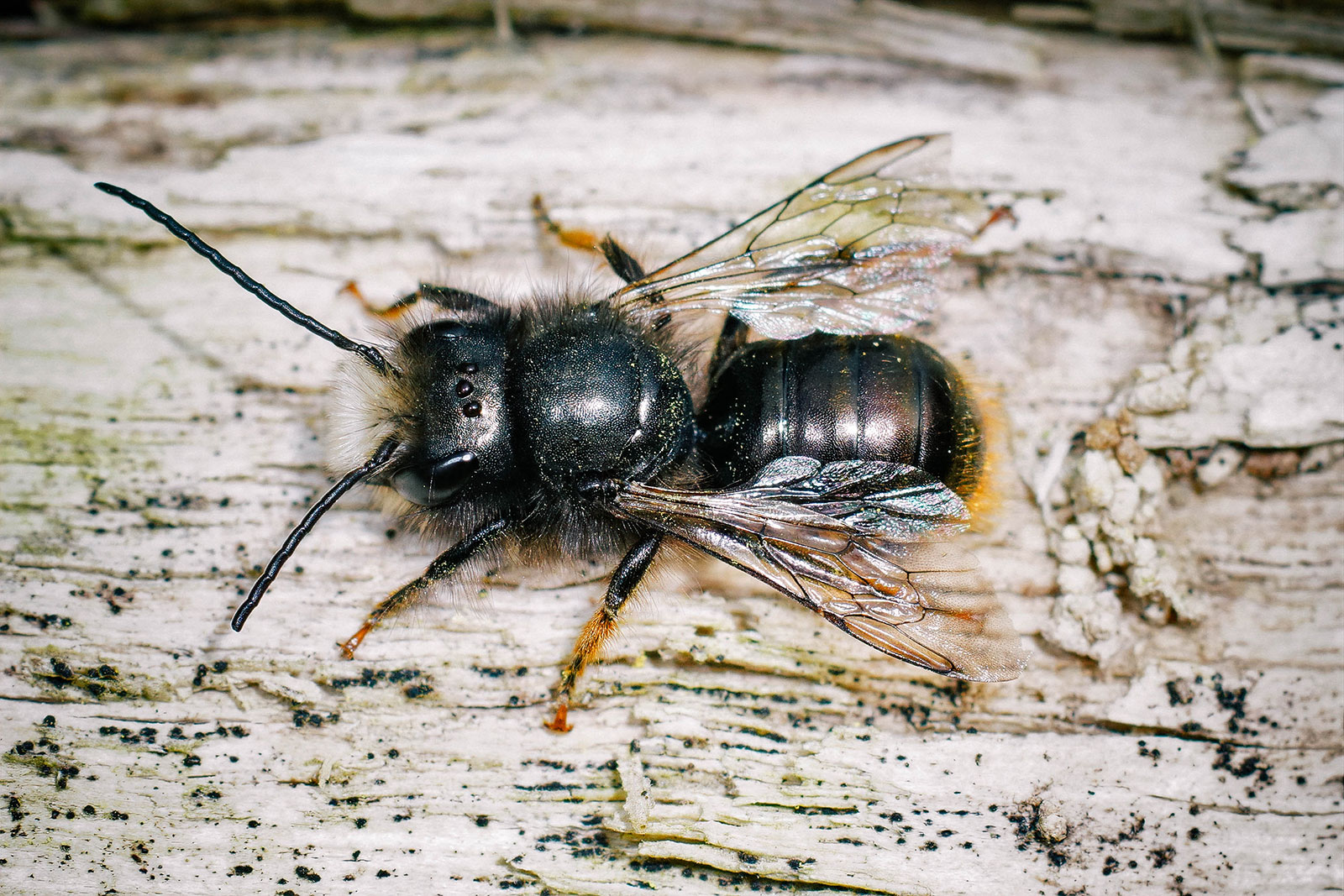
Mason bees belong to the family Megachilidae. They’re named for their habit of using mud or other masonry products to build their nests, which are made in small, dark cavities and naturally occurring crevices, like in between cracks in stone, inside hollow stems and twigs, and sometimes in “native bee hotels” that people hang in their gardens.
They are small, agile, and fast-flying bees, making them extremely productive pollinators. A type of mason bee, the blue orchard bee, is so called for its amazing pollination skills in orchards. Research has shown that about 400 female blue orchard bees are as effective as 10,000 honeybees when pollinating almonds!
Mason bees do not have pollen baskets on their legs. Instead, they carry pollen in hairs on the underside of their abdomens.
They commonly have metallic bodies in shades of dark blue, dull green, and black. Some species may be reddish or rust-colored. Adult mason bees are about half an inch long, and show an enlarged hind area when it’s full of pollen.
Leafcutter bee (Megachile latreille)
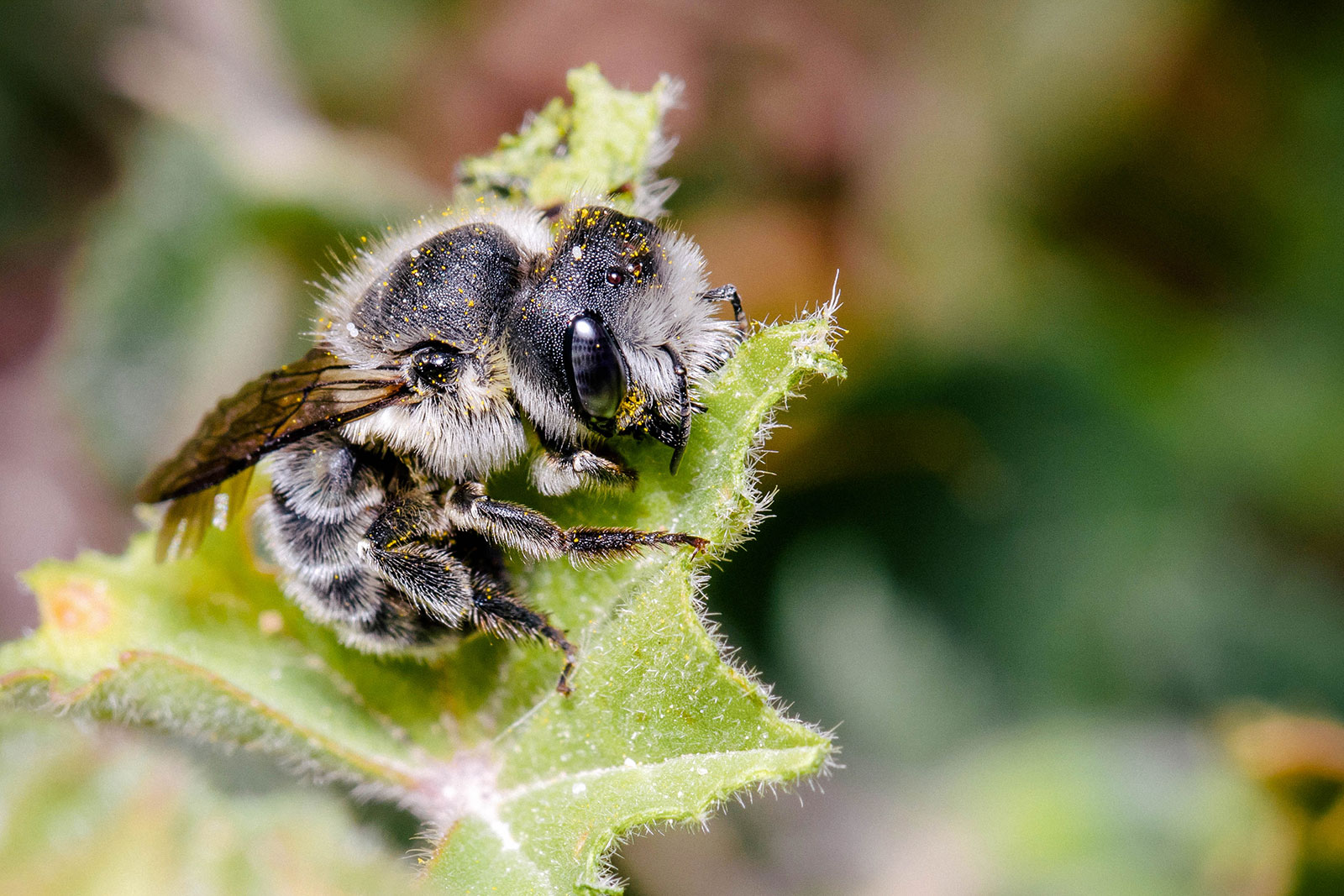
Leafcutter bees belong to the family Megachilidae.
They’re very similar to mason bees in their nesting habits, except they use leaves to close up their nest cavities. They do this by cutting away 1/4-inch to 1/2-inch crescent-shaped or near-circular fragments from the leaves of roses, lilac, and other shrubs.
Note that they’re extremely neat cutters, so if you notice jagged edges or tears along the edges, it won’t be the work of leafcutter bees.
These bees are black with white hairs covering the thorax and the bottom of the abdomen. Many species have large heads with massive jaws that aid in cutting off leaves.
They are very fast flyers and carry pollen on their abdomens. Research has found that leafcutter bees are incredibly efficient; about 150 of these bees working in greenhouses can pollinate the same amount of plants as 3,000 honeybees!
Southeastern blueberry bee (Habropoda laboriosa)
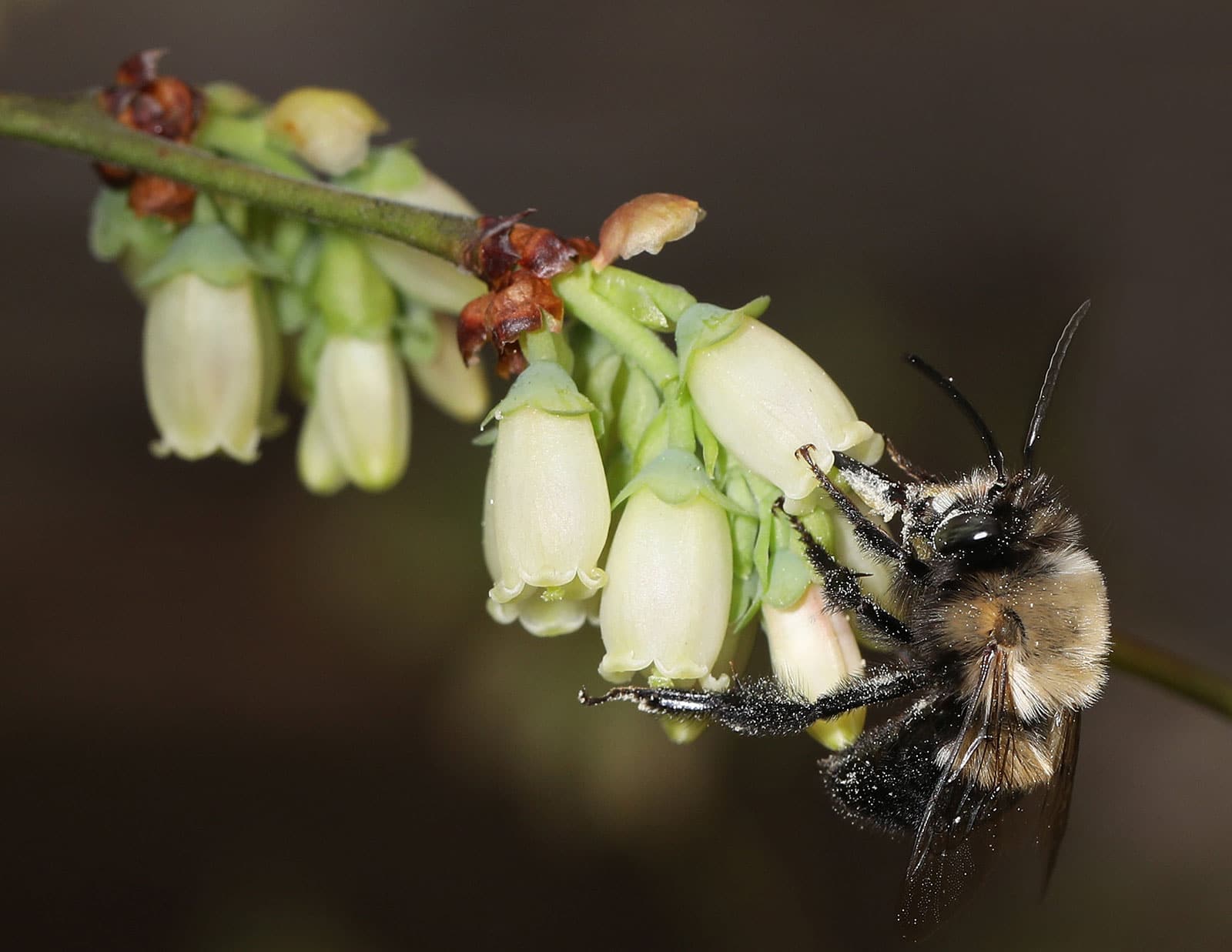
These bees belong to the family Apidae. As their name suggests, they are efficient pollinators of blueberries—in particular southern rabbiteye blueberries, which require buzz pollination (a behavior that few bees exhibit).
Interestingly, these bees have evolved with native blueberries, and their bodies fit perfectly inside bell-shaped blueberry flowers. At half an inch long, they resemble small bumblebees with their hairy bodies.
They also feed on other flowers (such as trumpetflowers and clover) and are native to the southeastern United States.
Blueberry bees are solitary bees that are most active from February to April. They’re strong flyers and tend to nest in the ground, especially near blueberry plants.
Squash bee (genera Peponapis and Xenoglossa)
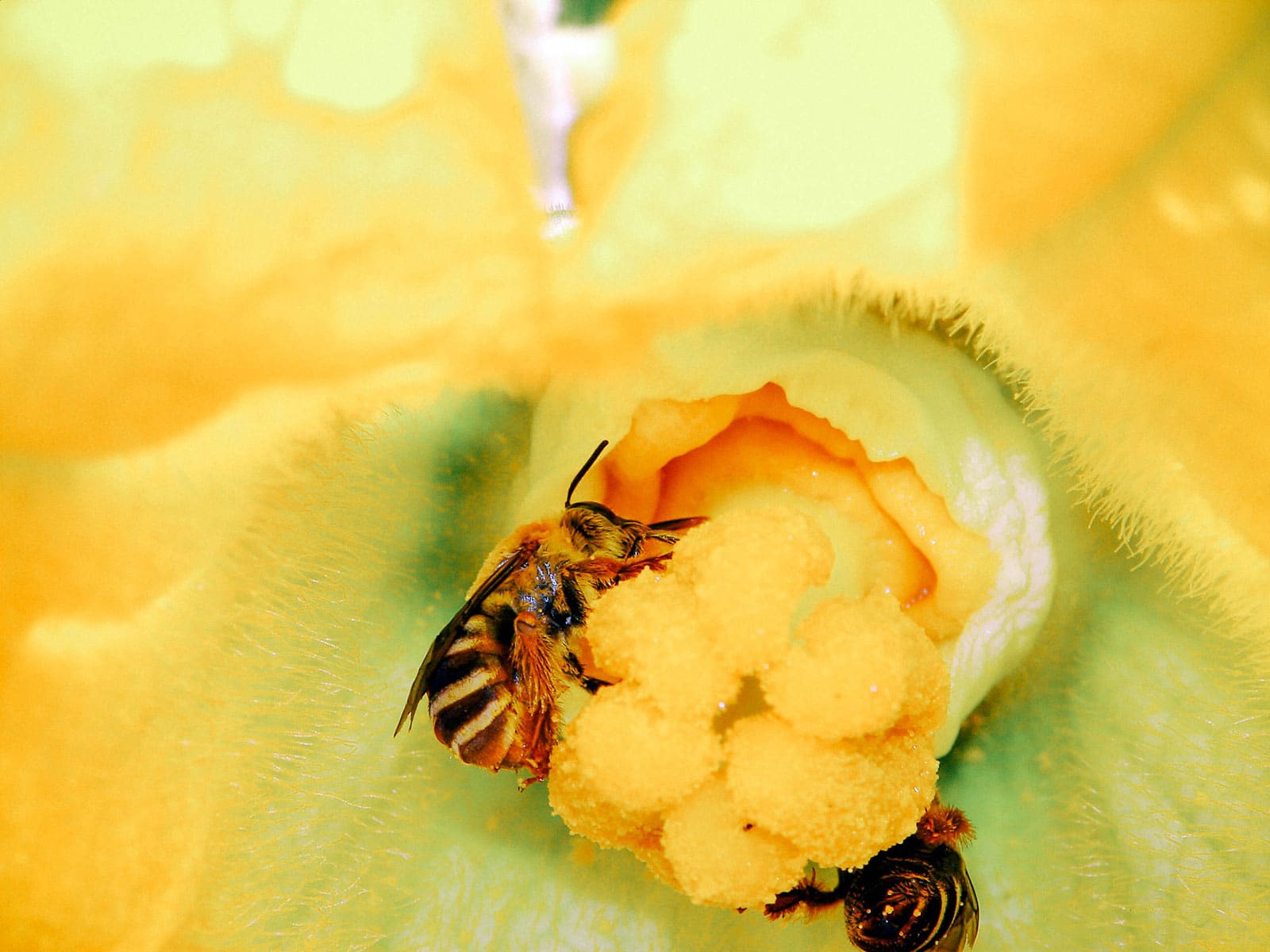
Squash bees belong to the family Apidae, but these native solitary bees come from two related genera, Peponapis and Xenoglossa.
They’re large and bulky like bumblebees, but are more similar to honeybees in their coloring. Compared to honeybees, they have rounder faces and longer antennae.
Before Europeans brought honeybees to the New World, squash bees were the main pollinators of squashes and gourds that were planted by indigenous peoples throughout the Americas.
These days, you can find male squash bees in the first few hours after sunrise, darting from squash flower to squash flower in search of mates.
Females feed on squash, pumpkin, and gourd flowers, their sole source of pollen. They’re excellent pollinators of zucchini and butternuts, among many other varieties of the cucurbit family, and are so thorough at their job that later visits by honeybees do little for those same crops.
These bees are solitary and live in nests dug in the soil. However, male squash bees sometimes spend the night inside closed flowers before they get back to work in the morning.
Hairy-footed flower bee (Anthophora plumipes)
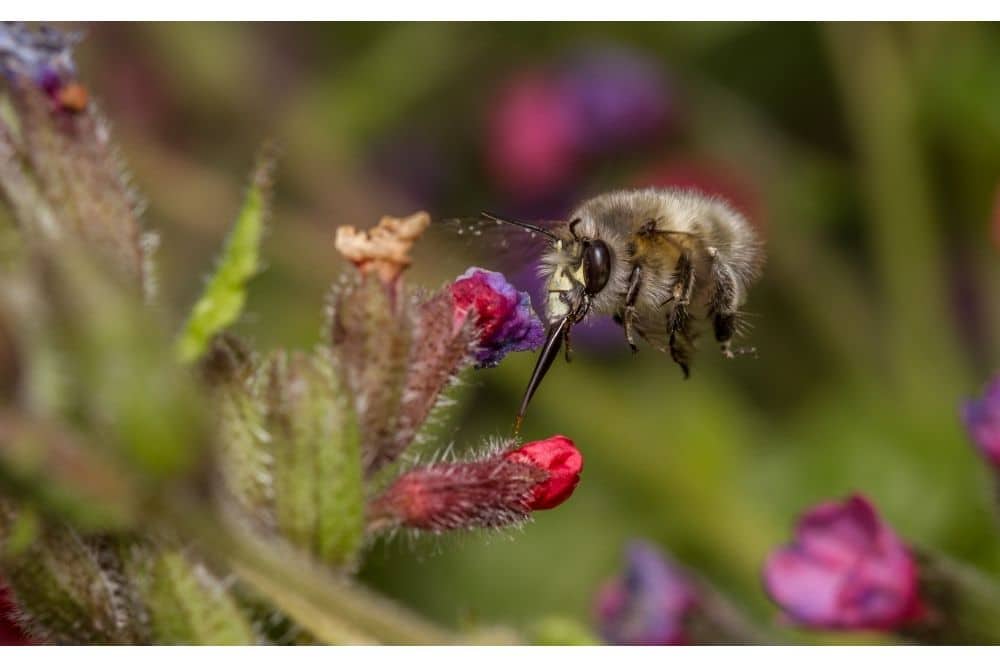
Hairy-footed flower bees belong to the family Apidae. They’re very important for the pollination of primrose flowers, dead-nettles, comfrey, and lungwort.
They measure between between 1.4 and 1.6 centimeters long.
The females of this species are similar in appearance to bumblebees but smaller. They are black and furry with orange hairs on their hind legs.
Male hairy-footed flower bees are a rusted brown color and have cream-colored hair on their faces. Look for long and feathery orange hairs on their feet and middle legs.
They commonly fall down chimneys and are known to hide in the cracks between bricks in the soft mortar. They also like to live in woodlands, parks, soft cliff faces, and soil.
You’ll likely see these bees between March and June. Males tend to be noticed first, emerging from their hibernation period slightly earlier than their female counterparts.
They fly in a very fast and darting manner, and and are known to be solitary bees. That being said, they like to nest in large and noisy groups.
Ashy mining bee (Andrenidae cineraria)
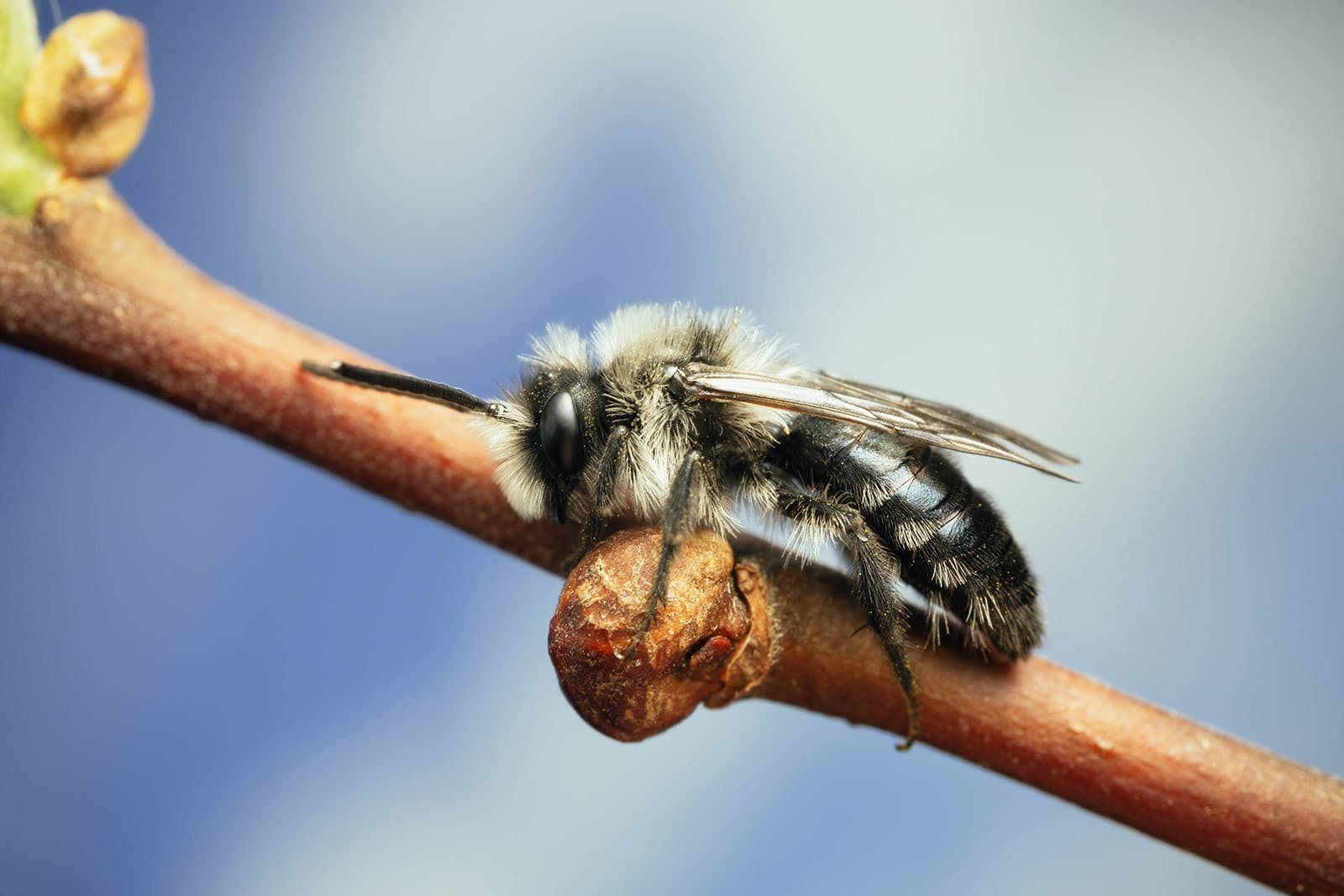
These bees belong to the family Andrenidae. They’re solitary bees most commonly seen during springtime. They are a very distinctive species with their black and grey coloring.
The females are the same size as honeybees. They have a shiny black abdominal area that can appear blue in some lights. Two distinctive stripes of light gray hair can be seen at the top and bottom of their thorax, along with white hairs on their face.
The males are smaller and have less easily recognizable markings than the females. The lighter-colored hairs on the sides of their thorax regions are more obvious, however.
Ashy mining bees are most active between March and June. They’re often found in open and sunny locations near sandy soil types.
The female bees make their nests by burrowing underneath bare earth. They like to feed on buttercups, blackthorn, hawthorn, and fruit trees.
Tawny mining bee (Andrenidae fulva)
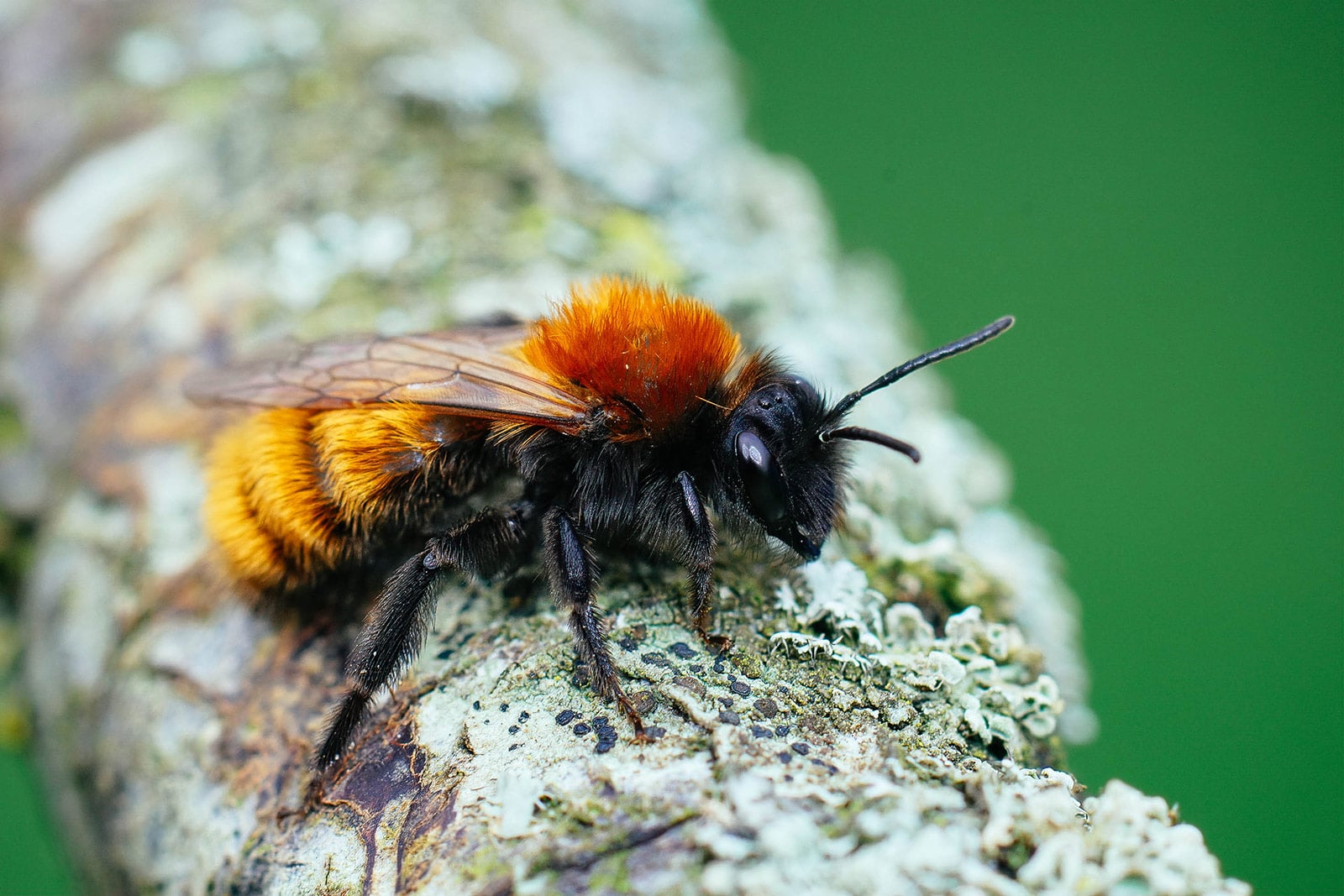
These bees belong to the family Andrenidae. They’re commonly seen in springtime between March and May
Female tawny mining bees are similar in size to honeybees. They have thick, reddish-orange hair on their thoraxes. The abdominal regions are covered in a long and dense layer of a lighter orange-colored hair. The undersides, faces, and legs of female tawny mining bees are all black.
Male tawny mining bees are thinner and smaller than their female counterparts. They have a thinner coat of hair that’s more brown in color. The jaws of male tawny mining bees protrude.
The males measure around 8 to 10 millimeters long and the females measure 10 to 12 millimeters long.
These bees can thrive in a variety of habitats. They’re often seen in gardens and parks with short and well-managed vegetation. They feed on buttercups, dandelions, maple, willow, fruit trees, and hawthorn.
The females build nests late in the spring after the males have mated and died. There is only one female bee per nest, making them a solitary species.
Ivy bees (genus Colletes)
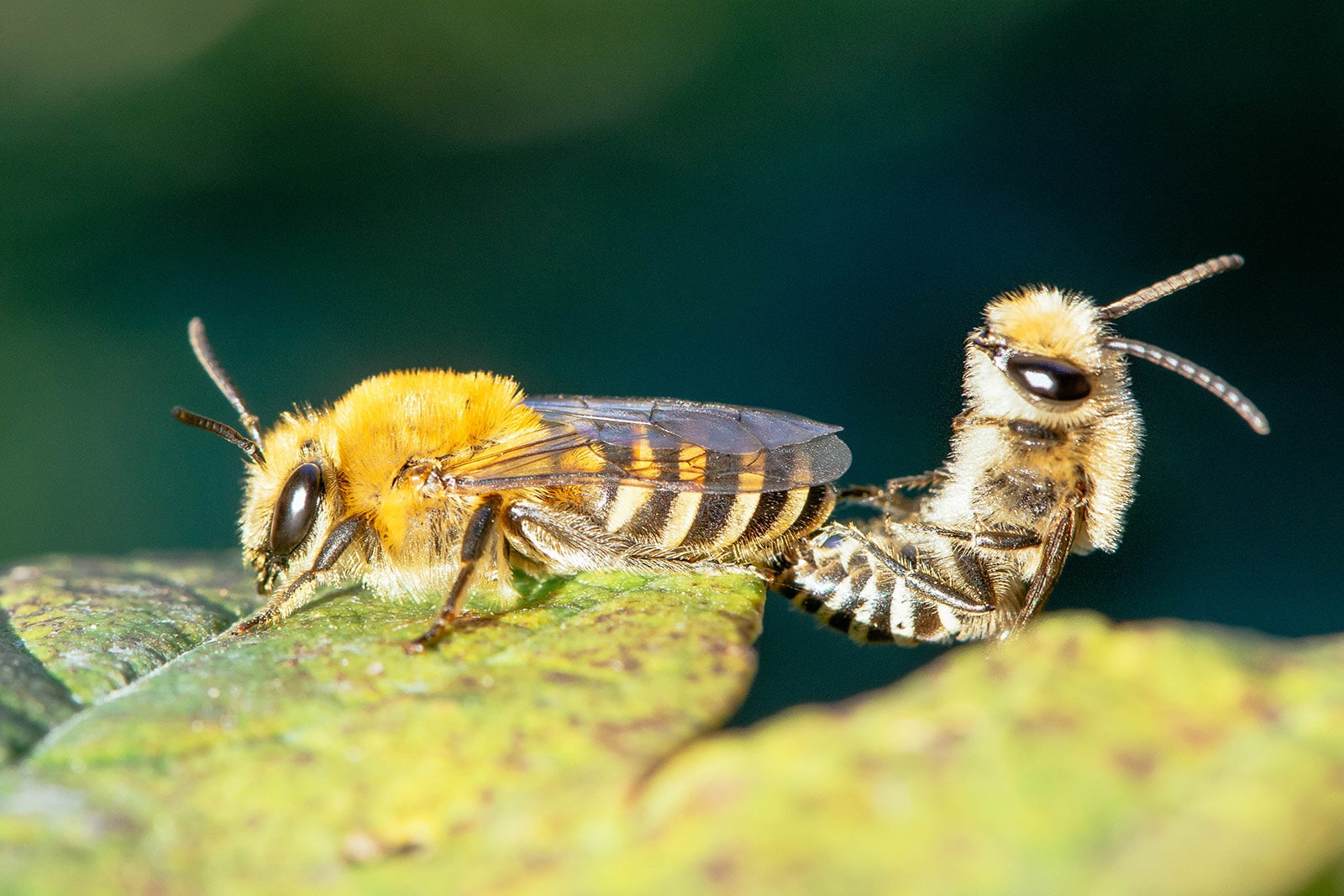
Ivy bees belong to the family Colletidae and are known as a type of plasterer bee or cellophane bee due to the way they line their nests.
They’re slightly bigger than honeybees and have ginger-colored thorax regions.
This area on female bees is very thickly coated in hair. The abdominal region has broad banding, alternating between black and yellowish-orange.
The males are smaller but similar in appearance. They can be hard to distinguish from other species of plasterer bees. The best way to tell them apart is by noting the time of year that you see the bee.
The ivy bee is active later in the year, with males emerging in late August and females in late September. They’re commonly seen in urban areas, farmlands, coastal areas, and in heaths. They are partial to ivy flowers and other late bloomers.
The males are in such competition for females that they often become entangled in a mating ball. This is a frenzy of activity where all of the bees attempt to mate with a singular female.
Yellow-faced bees (genus Hylaeus)

These bees belong to the family Colletidae. There are more than 130 species of Hylaeus bees in the United States.
Yellow-faced bees are said to resemble small black wasps. They have white or yellow markings on their legs, faces, and thorax regions, and have very slender bodies.
These bees are fairly unique in appearance as they do not have scopa (extra limbs to carry pollen around). Instead, these bees have special areas on their stomachs known as crops, where they store their food.
This solitary bee species tends to build its nests in tunnels that already exist. The female regurgitates the contents of her crop when she returns to her nest, leaving a small amount with each egg. This is what the babies will feed on when they hatch.
You’ll most commonly find yellow-faced bees between May and September on carrot plants and Golden Alexanders, as well as swamp milkweed and common boneset.
Furrow bee (genus Halictus)

Furrow bees belong to the family Halictidae, also known as sweat bees. They’re attracted to human sweat and will walk around calmly on your arm.
These bees are small and relatively docile in nature. They’re a ground-dwelling species and burrow into the soil to build their nests. They prefer to reside in areas without vegetation.
The bees can be hard to identify because they come in a diverse range of colors, from all black to gold to metallic greens and blues, and sometimes even purple or gray. The back ends of the abdominal regions have pale bands of hair.
Female furrow bees are distinguishable by their robust heads that feature a genal tooth (a small spine in the cheek area behind the eye).
Box-headed blood bee (Sphecodes monilicornis)

These bees belong to the family Halictidae.
They are medium to large bees and are easily recognized by their abdominal regions, which are blood-red in color. Colloquially, they’re known as “blood bees.”
This species is cleptoparasitic on other bees, especially in the genera Halictus, Andrena, and Lasioglossum. This means they use other bees’ provisions to feed their young, so they themselves do not collect pollen (though they do feed on nectar).
The females enter other bees’ nests and destroy any grub or eggs they discover inside. They then lay their own eggs to replace the ones they destroyed, and leave the nest, sealing it back up as they do so.
The males are smaller than the females and have less red visible at the top of their abdomen. This specific species of blood bee has a slightly flattened antennal region compared to the others.
The females have a distinctly box-shaped head and pale hairs found on their back legs. They also have relatively thin bodies. They have two main eyes and three ocelli (primitive eyes found on the top of the head between the two main eyes).
They tend to be found near orange-legged furrow bees, common furrow bees, bloomed furrow bees, and sharp-collared furrow bees, as they use the nests of these species as hosts.
Carpenter bees (genus Xylocopa)
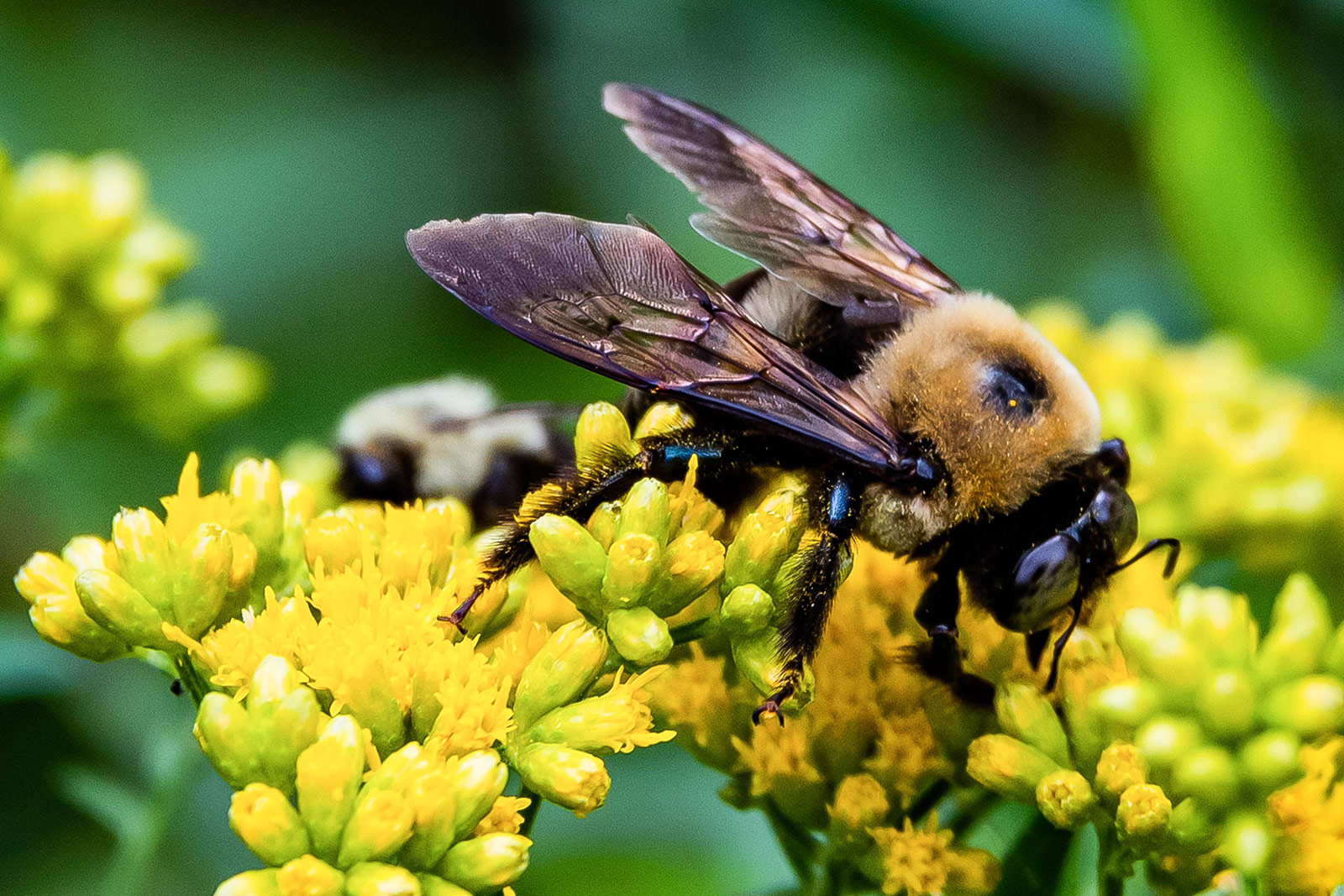
Carpenter bees belong to the family Megachilidae. They are the largest native bees in the United States and a solitary species.
They thrive in a range of conditions including tropical and subtropical climates, and are common in eastern North America.
These large bees have a black and hairless abdominal region. The males can sometimes have patches of short hair on the abdomen and a yellow or white face. They may also have a white dot on their heads. Female carpenter bees, however, have black faces.
They’re approximately 1/2 inch to 1 inch long and sometimes mistaken for bumblebees. While most carpenter bees are black, some species may be green or purplish in color.
They have distinctive nesting habits and create nests that are nearly perfectly round by drilling tiny holes into wood, hence their name. Though carpenter bees are important pollinators, they’re sometimes considered a nuisance because of the damage they do to wooden surfaces in homes and yards.
Wool carder bees (Anthidium maculosum)
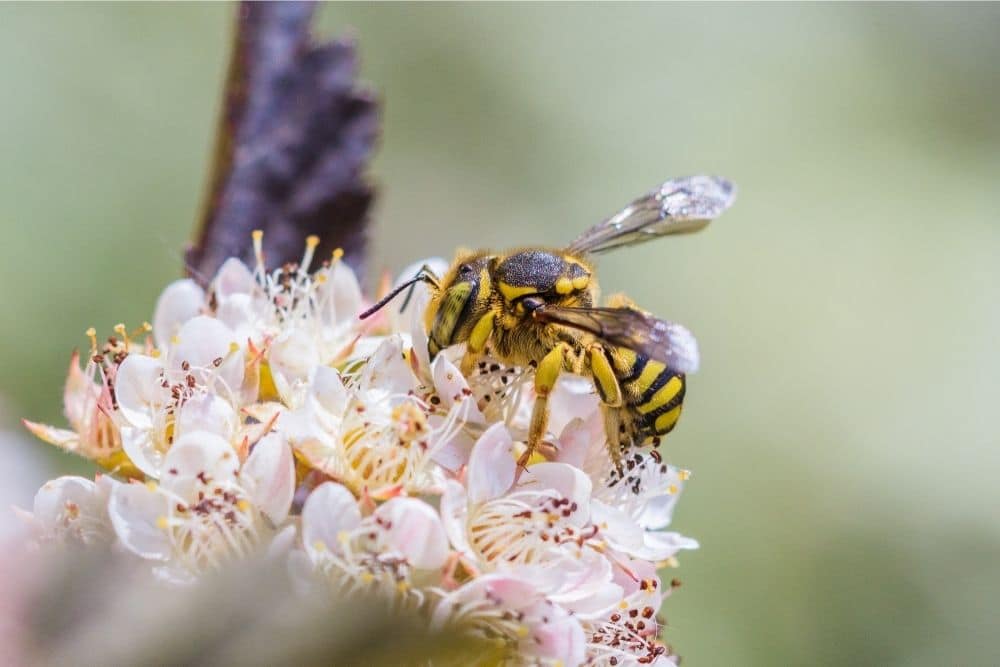
Wool carder bees belong to the family Megachilidae. They get the name “carder” from their habit of scraping hair off of fuzzy leaves like lamb’s ears and mullein.
This type of bee has a distinctive pattern on its body, with yellow spots down the sides of its abdominal region. And while most bees carry pollen on their hind legs, carder bees are unique in that they carry pollen on their abdomen.
The males are larger in size than the females, which is unusual for bees.
On the males, you can see visible spikes at the ends of the abdominal area (where a sting would typically be, though males in this species lack stings). The head, thorax, and abdominal area are covered in pale, yellowish-gray hair.
The females are less hairy than the males. They also have stings instead of spikes on their abdomen. Their main purpose is to collect wool fibers from plants and bring them back to their nests.
You’ll commonly see these bees in woodlands, wetlands, riverbanks, and cliffs. They like to find existing holes to make their nests in, such as dead wood and hollow stems.
Pantaloon bees (Dasypoda hirtipes)

These bees belong to the family Melittidae. If you’re wondering why a bee is named after a pair of trousers, take a look at the females. They have large orange pollen brushes on their hind legs, giving the impression that they’re wearing pantaloons!
They are medium to large in size and are primarily golden-brown colored. The bands on their abdomen are golden-brown and black.
The males have long, golden hairs and similar banding to the females. The hair on their back legs is longer but they don’t have “pantaloons” like the females. In the sun, the color of the males can fade to a silver-white color.
Pantaloon bees are often seen near the coast and in heaths, as they like the sandy soil. The pantaloons are designed to help excavate sand as the females exit their burrows.
This means that their nests have a soil heap arranged in a fan shape, making them visually different from other mining bees.
They are found in large groups with one female each. They only really like flowers in the aster family, like ragwort, oxtongue, and cat’s ear.
More helpful resources on bees:
- Foolproof Five: The Best Plants to Grow for Bees
- Let’s Talk About Native Bees and Why We Need Them
- How to Stop Carpenter Bees: 6 Simple Tricks That Work (Without Toxins)
View the Web Story on identifying different types of bees.


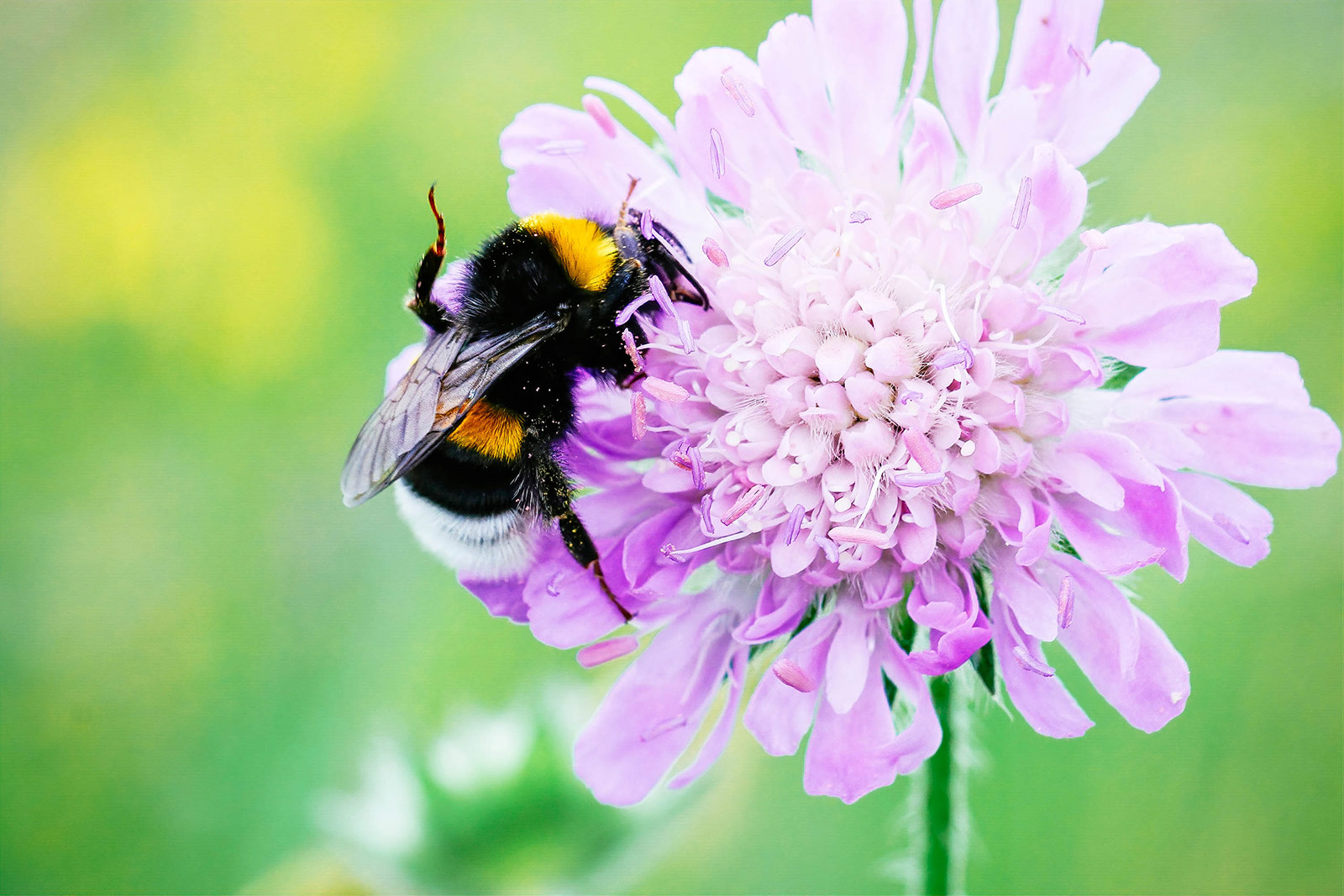













Such an interesting article about bees today Lynda. Fantastic!! I had no idea that there were so many species.
I like Joy
I love this article, you have so much great information! However in the introduction you said a few incorrect statements. Most female bees and wasps can sting multiple times but are difficult to provoke to because many are solitary and are not defending a large hive. Honey bees are one of the few insects with barbed stingers meaning they can only sting once because it often gets impeded in your skin ripping it from your body. Yellow Jackets and Hornets are social wasps meaning they are far more aggressive then most solitary wasps usually will ignore people entirely and their sting is not very painful because its purpose is to sting their prey of other insects. Not large mammals!
Oh my, we must be talking in relative terms. I can’t bring myself to say the social wasp sting isn’t “very” painful. I grew up running from yellow jackets and especially hornets and bumble bees. I know theoretically, the stings of the “cow killer ” (as we kids nicknamed the big scary red ones) bees and ants hurt a lot more, reported by acquaintances who have personally experienced them, but I hope I never find out. One recent run-in with a giant red wasp, supposedly imported in recent years, was enough for me to understand how one could say some stings are “very” painful and others are not. Nonetheless, I love all the little buzz bombers and have been slowly adding bee and hummingbird plants every year. Thank you so much, Linda, for this great article. I’ve seen numerous new pollinators in my yard that I now can recognize by name thanks to you.
While growing up in California, there was a bee that had horizontal lines and one vertical line. We called them “H” bees. Are they still around and what are they called?
Amazing post, thanks for sharing this article. I am truly motivated by you for blogging. Thank You.
I HAVE PURCHASED A NUMBER OF BEE IDENTIFICATION BOOKS AND SO FAR ALL THE IDENTIFYING PHOTOS ARE FAR TOO SMALL TO TRULY DISCERN THE BEES’ ‘PHYSIQUES’…! I AM NOT AT ALL SOMEONE WHO STUDIES BEES BUT I TAKE PHOTOGRAPHS AND THEREFORE CAN ENLARGE THE IMAGES AND VIEW THE BEES MORE COMPLETELY. I HAVE YET TO FIND A BOOK WITH ADEQUATELY SIZED PICTURES…….SO THANK YOU! YOUR PHOTOS HAVE REALLY HELPED………
You’re welcome Susan! I’m glad this guide was helpful!
Quick question about the photos, do you take this pictures? Because if you do they are really good. In case they aren’t, could you write the names of the authors too along with the bee name? It would be really cool to go to the source and check other stuff these photographers do, and also it would definitely help them to reach a bigger audience. Thanks!
Aren’t carpenter bees in the family Apidae, not Megachilidae?
Yes, they are in fact in the family Apidae.
What bee looks like a honey bee, but has a really painful sting….AND, I do mean painful? This thing stung me on the inside of my arm, just above my elbow. It hurt like heck and for several days. My arm was sore all the way up to my shoulder. Any thoughts? Thank you!
Forgot to mention that I live in Southwestern Central PA
Sounds like a yellow jacket. They hurt!
I have a bee that always to be a bubble bee but it has a black fuzzy abdomen. I found it mowing the grass near a tree stump. I do have a pictur.. my son is autistic and terrified. I’m trying to find reading material but cannot figure out what it is.
I recommend sending the picture to your local Cooperative Extension service and they’ll likely be able to ID your local bees.
there is a big black bee with a fuzzy yellow abdomen and is around a inch and a half long with a white dot on it’s face me and my husband have no idea what it is
This article describes that bee. Have a look. Read the words of the article and see
It is almost imposible ID a bee just with simple color pater description, it could be many things, Anthophora, Eucera. At least you would need a photo. However, the white dot on the face could suggest it is a male.
Overall, this was a well-written and informative article. However, there is one mistaken assumption repeated throughout.
Scientists are still mapping the genomes of various flora and fauna, including bees. As a result, we cannot yet confirm whether different bees have gender markers or what those markers are. Additionally, as the species Homo sapiens has eight known gender configurations ranging from 45XO to 49XXXXY, plus chimeras and 46XY androgen insensitivity (the only gender configuration exclusive to the female sex besides 45XO), there is no way to predict the variation of gender markers in bees – or if these chromosomes even exist – prior to proper genome matching. This is further complicated by the fact that genome mapping is almost always restricted to a single sample with the exception of Homo sapiens, meaning a finished genome sequence fails to illustrate the genetic diversity within a given species.
I have a large (1″ long) fly/bee that does its mating fly (mostly hovering) over my back wood porch in lower Michigan. The head/thorax is bright yellow and abdomen is pure black – no apparent hair on the black parts. Would like to know where to send photo to help identify – can’t find anything like it on the internet or in my insect book. I’m afraid it bites!
I recommend sending photos to your local Cooperative Extension office who would be more familiar with the local bees.
That sounds like a Carpenter bee.
“Professor”. Good one lol. There are zero genders that exist in the human species Homo Sapiens. There are sexes. Gender refers to masculine and feminine nouns in certain latin based languages. Despite what someone thinks about themselves, they are exactly what their biology determines they are. Your DNA cannot be thought away, and neither can your chromosomes. Bees also don’t have gender, they have sex. Maybe you should learn bee and ask one what they identify as
When exactly do you think we entered the twilight zone? Is there a way out for those of us that didn’t want to enter?